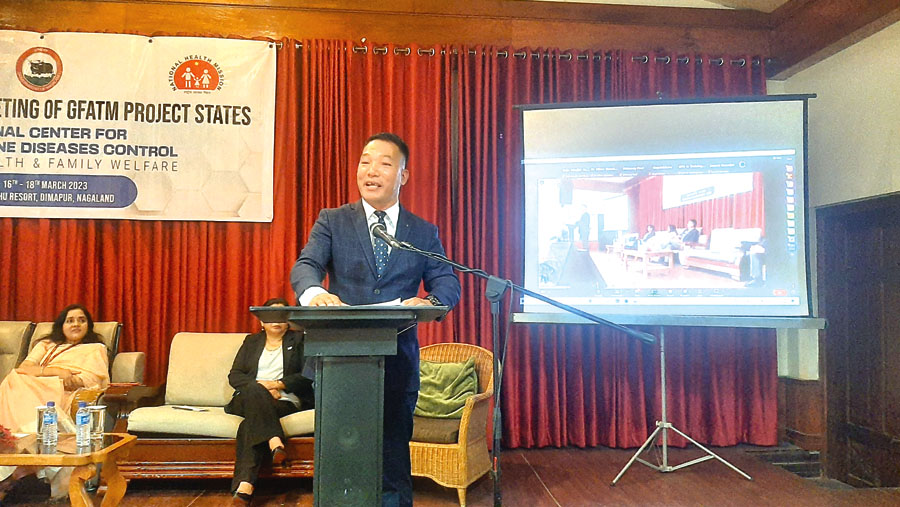WEDNESDAY, JULY 16, 2025
- Home
- No malaria-related deaths in state since 2017, says Health minister
No malaria-related deaths in state since 2017, says Health minister
Published on Mar 19, 2023
Share

DIMAPUR: There were a total of 185 reported deaths due to malaria in Nagaland between 2005 and 2022 but no deaths related to the disease have been recorded since the case in 2017, said minister of Health and Family Welfare P Paiwang Konyak.
Speaking at a high-level review-cum-dissemination meeting at Niathu Resort, Chümoukedima on Saturday, he said the National Vector Borne Disease Control Programme (NVBDCP) in Nagaland is steadily progressing towards its goal of making the state malaria-free.
[bsa_pro_ad_space id=1]He informed that workers operating under the National Centre for Vector Borne Diseases Control (NCVBDC) in Nagaland detected a total of 8,489 malaria cases in 2009 and 35 people fell victim to the deadly disease.
Expressing satisfaction over successful reduction of the malaria cases and controlling morbidity as well as mortality rates in Nagaland, he credited the achievement to the support provided by Global Fund and the efforts of the directorate of NCVBDC.
He also mentioned the malaria control programme has been particularly effective in three districts of Nagaland, namely Mokokchung, Longleng, and Zunheboto, adding that no new cases have been detected in these districts over the past three years.
The minister informed that in 2022, no positive cases of malaria were recorded in seven out of 16 districts in the state and congratulated all the stakeholders involved in achieving this feat. He urged the gathering to continue their efforts towards making Nagaland a malaria-free state.
Konyak also informed that the government of Nagaland has initiated new programmes, including screening of suspected cases along the international border with Myanmar; screenings of paramilitary forces, migrant workers, and laborers to combat malaria and ensure the safety of all citizens.
Expressing concern over the emerging trend of other vector-borne diseases such as Japanese encephalitis and dengue in the state, the health minister said one death due to dengue was recorded in 2015 and two deaths due to Japanese encephalitis in 2022.

In light of these developments, Konyak urged the ministry of Health and Family Welfare as well as the government of India, to provide logistical support to Nagaland and also to advise concerned departments to remain vigilant in order to prevent any deaths or illnesses due to vector-borne diseases.
Providing a brief update on the two-day activities of the Intensified Malaria Elimination Project-2 (IMEP-2) and the NCVBDC regional review meeting of Global Fund to Fight AIDS, Tuberculosis and Malaria (GFATM) states, which concluded at Niathu Resort on Saturday, Director of NCVBDC under the Ministry of Health and Family Welfare, Government of India, Dr. Tanu Jain, highlighted the current status of vector-borne diseases (VBDs) and highlighted the achievements and challenges of IMEP-2.
Jain informed that in 2022, eight districts in Nagaland, 12 in Manipur, 13 in Arunachal Pradesh, and six in Assam reported zero indigenous cases of malaria.
He added that in 2022, Nagaland, Assam, Arunachal Pradesh, and Manipur reported zero deaths from malaria; that Nagaland has implemented case-based surveillance and foci investigation to track the disease, while Assam has established a robust entomological setup.
He highlighted some areas that require improvement to effectively tackle malaria which include intensifying mapping of high-risk mobile populations, increasing surveillance and screening activities, particularly in hard-to-reach areas, and strengthening efforts at international borders.
Jain also stressed on the importance of regular and timely submission of reports by ASHAs and other health workers, as well as proper utilisation of GFATM funds to combat malaria effectively.
In his welcome address, Y Kikheto Sema, Commissioner and Secretary of Health and Family Welfare department, emphasised the need for constant coordination, cooperation, confidence, and contribution in the fight against malaria to achieve the goal of eliminating malaria by 2030.
He mentioned that the state experienced its darkest period in terms of malaria cases and victims during the late 1980s and 1990s. He added highest number of deaths due to malaria was reported in 2006 with 75 casualties, while 2009 saw 8,489 positive cases.
However, he expressed satisfaction that Nagaland has the lowest number of malaria positive cases in the Northeast region today.
Sema mentioned that the aim of eradicating malaria is consistent with the WHO technical strategy and roadmap, which stipulates that the whole country should report zero indigenous cases and deaths due to malaria by 2027.
It is important to encourage all states to work diligently to achieve this objective, he added.

